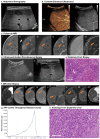Practical Considerations for Odevixibat Treatment in Patients with Progressive Familial Intrahepatic Cholestasis: A Single-Center Case Series
- PMID: 39768432
- PMCID: PMC11676709
- DOI: 10.3390/jcm13247508
Practical Considerations for Odevixibat Treatment in Patients with Progressive Familial Intrahepatic Cholestasis: A Single-Center Case Series
Abstract
Background: Patients with progressive familial intrahepatic cholestasis (PFIC) experience cholestasis-associated symptoms, including severe pruritus. Odevixibat is an ileal bile acid transporter inhibitor indicated for treatment of PFIC in the European Union and for the treatment of pruritus in PFIC in the United States. The aim of the current study was to characterize the real-world effectiveness and safety of odevixibat in patients with PFIC. Methods: This retrospective study included 9 patients with PFIC treated with odevixibat in a single center in Tübingen, Germany. Data were recorded using case report forms. Results: Of the 9 patients (PFIC1, n = 2; PFIC2, n = 7), 5 had improved serum bile acid levels, pruritus, liver function tests, and sleep with odevixibat treatment. Two siblings with periodic relapses of PFIC symptoms also had improved pruritus and sleep within 4 months of treatment. Two siblings with complete loss of bile salt export pump (BSEP) protein did not respond to treatment; both underwent liver transplantation (indications: hepatocellular carcinoma [HCC] manifestation [n = 1] and severe failure to thrive and refractory pruritus [n = 1]). Four patients reported abdominal complaints that were transient or responded to dose reduction; no other safety issues were reported. Conclusions: In this case series, clinical benefits were observed in most patients with PFIC1 and PFIC2 treated with odevixibat. In patients with periodic relapse of PFIC symptoms, ≥3 months of treatment with odevixibat may be required for symptom control. Patients with complete loss of BSEP did not have consistent symptom relief and require careful monitoring. Effectiveness and feasibility results from our cohort demonstrate potential for long-term benefits with odevixibat in real-world treatment of patients with PFIC.
Keywords: odevixibat; progressive familial intrahepatic cholestasis; pruritus; serum bile acids.
Conflict of interest statement
M.M., J.H., C.P.B., I.T., and S.S.: nothing to disclose. S.H.: Albireo, an Ipsen company, Mirum, Astellas—research support, invited speaker; Nutricia, Orphalan—invited speaker. E.S.: Albireo, an Ipsen company, Mirum—consultant and research support; Univar—Consultant; Orphalan—speaker’s fee. Role of the funder: Albireo Pharma, Inc, an Ipsen company, funded editorial and medical writing support and reviewed the manuscript for accuracy; the funder had no role in the design, execution, or interpretation of the study.
Figures



References
-
- van Wessel D.B.E., Thompson R.J., Gonzales E., Jankowska I., Sokal E., Grammatikopoulos T., Kadaristiana A., Jacquemin E., Spraul A., Lipiński P., et al. Genotype correlates with the natural history of severe bile salt export pump deficiency. J. Hepatol. 2020;73:84–93. doi: 10.1016/j.jhep.2020.02.007. - DOI - PubMed
Grants and funding
LinkOut - more resources
Full Text Sources

